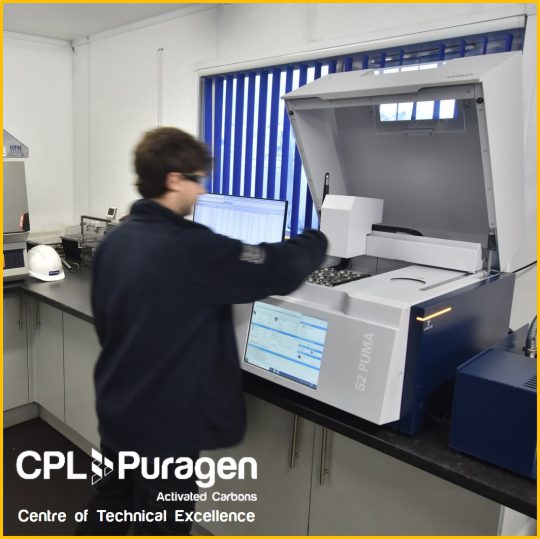Our Centre of Technical Excellence, located at our award-winning Immingham Reactivation plant, has just taken delivery of a brand-new XRF machine, to assist with activated carbon characterisation.
The new equipment, called an S2 Puma EDXRF (Energy -Dispersive X-Ray Fluorescence) machine, supplied by Bruker, is a state-of-the-art piece of equipment that allows our technical team to test the composition of spent activated carbons, forming part of our Carbon Acceptance procedure prior to thermal reactivation in our REACT-Sys® process.
In addition to higher molecular weight inorganic contaminants (e.g. metals), this high-power XRF also allows us to detect lower molecular weight species, including fluorine. This is especially important in measuring spent carbons that have been used for the abatement of PFAS-group ‘forever chemicals’, a key concern in the water industry currently.
Not only will this allow us to identify and measure PFAS-laden spent carbons, which we can already safely reactivate at Immingham, it will also indicate where a customer may benefit in switching from a standard activated carbon to our new range of FiltraCarb® CH products, which have been optimised for PFAS removal.
Another element that the new XRF can measure is sulfur, which is a key contaminant seen in carbons used in the biogas & biomethane industry (formed from H2S in the biogas). It will allow us to identify ‘high-sulfur’ spent carbons, which can now be processed via our ‘CR3’ reactivation technology. We are the only carbon company who can handle these ‘difficult’ heavily-loaded spent carbons.
This new XRF has 20 sample chambers, allowing a faster throughput and higher output than the machine it replaces, which will prove a vital tool as our business continues to grow.
In addition to its role in the characterisation of spent carbons, the new XRF will also prove extremely useful for the wider QA/R&D teams, allowing them to analyse virgin carbons, impregnated grades, feedstocks, as well as being used for general QC/R&D tasks.
This latest investment again shows our commitment to the recycling of activated carbon, wherever possible, to achieve a circular environmental filtration solution.

